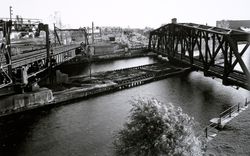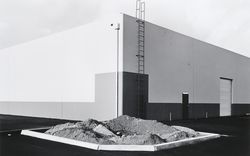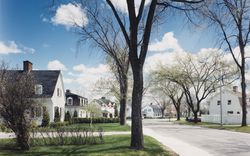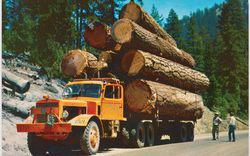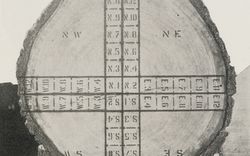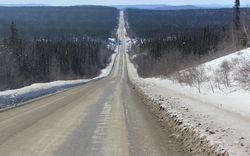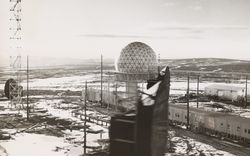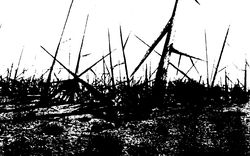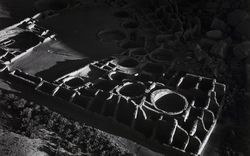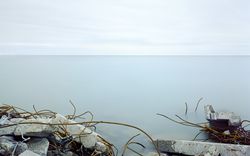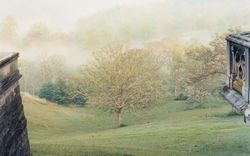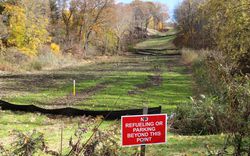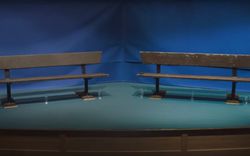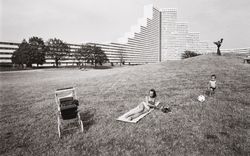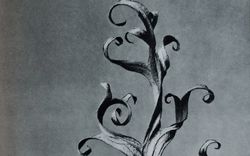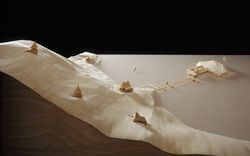Olmsted, Burley, Friedlander, James
Three contemporary photographers interpret the work of Frederick Law Olmsted
Frederick Law Olmsted shaped much of the public landscape of North America in the second half of the 19th century. He is best known for his urban parks, including Central Park in Manhattan and Prospect Park in Brooklyn. But his enormous output also included entire park systems (The Emerald Necklace, Boston); suburban communities (Druid Hills, Atlanta); university campuses (Stanford University, Palo Alto, California); private estates (“Biltmore,” the George Vanderbilt Estate, Asheville, North Carolina); cemeteries (Mountain View, Oakland, California); and conservation schemes (Yosemite Valley and Mariposa Big Tree Grove, California). His vision of how planned green spaces might function in the life of increasingly crowded cities would influence public space in North America for generations.
Through a commission from the CCA initiated in 1988, three contemporary photographers spent seven years interpreting the work of Olmsted. By giving them the opportunity to visit the sites many times in different seasons, or in the same season several years later, the Olmsted commission sought to create an intense concentration on place. The 74 representative sites in the project were selected by Olmsted scholar Cynthia Zaitzevsky, who provided documentation to the photographers on each location. The photographers brought sharply different approaches to the commission. Robert Burley created chromogenic colour prints, using a 4 × 5 view camera. Lee Friedlander worked in black and white, using a Leica, a 2¼ square Hasselblad, and a panoramic camera. Geoffrey James also worked in black and white, using an 8 × 10 view camera and a panoramic camera. The photographers’’ personal visions and their ideas about Olmsted were equally distinct, evolving gradually over the course of the commission.
Robert Burley
I think one of the important lessons of that first trip to the Olmsted park system in Boston in 1988 was that these sites were overwhelming. They were huge spaces you could spend days walking through and still have missed very important parts. They were places that changed not only on a season-to-season basis, but week to week, even day to day. Often, I would find after having visited one place and gone back a few days later, there would be some change in the foliage or the activity that made it quite a different place from the first time I visited. So it was in many ways an ongoing and never-ending search for not only good pictures, but a search for an overview of these particular sites.
I saw myself as someone trying to record an essence of a place, to try to get at some deeper quality or feeling of what a place was like to be in. When you’re trying to achieve this, really all you can rely on is your own personal experience and how your past experience relates to the situation and place you’re in at the time.
I was constantly trying to place timeless elements next to those that were in flux. And to make a suggestion of an infrastructure that stayed put next to a landscape that was changing on a day-to-day basis and the activity of people who were changing on a minute-to-minute basis. So the element of time is a subtle undercurrent that I tried quite hard to produce. But it is a very definite undercurrent in the work.
I felt that especially places like Central Park had not only a very deep history in a public sense, but a very deep history for a lot of the people who have used them over the years. It was a feeling I’ve always had walking through Central Park. You wonder about the millions of people who have used that park over the years and all the day-to-day rituals that have taken place over and over again. One of the photographs to suggest that idea is one photograph at the Ladies’ Pavilion, by the lake, with a rock formation. In it are two lovers who were aware of me bumbling away over by the Pavilion. With my equipment, my tripod, and my view camera. I wasn’t inconspicuous. I couldn’t steal photographs with my subjects unawares. I think they felt I wasn’t really including them in the photograph and if they did, they didn’t care: they were necking and having a wonderful time, so it didn’t matter. But near the lovers on the rock and just below them, on the rock formation, there’s all sorts of graffiti, all sorts of personal notes about so-and-so loving so-and-so, and little love poems.
You’re trying to make pictures; you’re caught up in all the logistics of trying to catch these figures somehow in a relationship to all these other elements: the rock formation, the decorative ironwork of the Ladies’ Pavilion, the spring trees in the background, the lake. I didn’t even notice the graffiti on the rocks until after I enlarged the image. I didn’t notice it while I was there. But once I had worked away in the darkroom and made a final print of this particular image, I was very pleased with it. It really did suggest that this is where love has taken place over and over again, that somehow this place lends itself to this very spiritual activity. These kinds of pictures were very difficult to come by; they were few and far between.
I’ve developed a strong respect for Olmsted. As a result of being able to return to a number of parks over a period of years, l found that they were constantly reinvented places, not just through the change of seasons and the different activities that took place there, but through Olmsted’s design skills. He was someone who really had an immense talent for manipulating not only the landscape but the way people experienced it. Being a picture-maker, one tries to be aware of how people view your pictures and how you can manipulate their eye around an image. Olmsted, as someone who created landscapes, was incredibly successful at manipulating me in a very deliberate way around his landscapes. Even when I was very much aware of it, and even when I tried to find alternative routes, I found myself following a kind of itinerary that I think he had probably developed. This was one of the most interesting realizations about these parks: how they were not designed just as beautiful places, they were designed very carefully to be experienced in a very deliberate manner. That’s an amazing thing to be able to do, especially considering the scale and complexity of most of them. They’re not backyards; these places consist of acres and acres of land. In the beginning I assumed there were probably areas he concentrated on more than others, but it was always the whole place. It was always from one edge of the park to the other.
Lee Friedlander
I like commissions generally. I have also turned down commissions that did not interest me. The Olmsted one is peculiar in that it came at the same time that I had become personally interested in landscapes. It was perfect timing. Usually you end up using what you know rather than discovering all the time, whereas in this project it was more of a discovering experience because I was and am now trying to learn about landscapes. Plus the project occurred in places that often resembled natural landscapes. Obviously Central Park resembles the city too, not just the woods. Let’s drop the word commission and say that with the material, one could spend six years or a lifetime at it. There is no real end point; if you were crazed enough with Olmsted or parks, you could really just keep going forever. I love them because they have perimeters and you are stuck with what is inside of a box in a sense.
I hadn’t a clue about anything on Olmsted. I figured, if what he did is worth its salt, it will be in the pictures, somewhere. I didn’t think I needed to be a scholar, but give me the raw material and let me see what I can make with it. I also knew that Geoffrey was very involved with the idea; he always would try to tell me [facts about Olmsted], and I’d say, “Okay, Geoffrey; I’m glad to know that.” But I just wanted to be let loose in these places and see what happened. I figure it’s inevitable that if you moved as much dirt as Geoffrey once told me was done—it’s got to be clear that something’s there. I don’t go with too many preconceptions of what’s possible. In a sense you want to approach it with a certain kind of innocence. I do, that’s my game.
I tend to like places that aren’t flat. So I probably stayed away from those big fields and went toward the hilly parts or the parts with water. It just gives you some other games to play. I tend to like more than one thing in my pictures. l don’t know why, but it’s one of the pleasures I get out of doing it. I think the hardest places were the subdivisions. It’s hard to know what to do with them.... I think that Riverside is probably one of the better shapes of a suburb; it also had a big park on a river, so it was very pretty. There was lots to do there. The ones in Boston were more city—like and there was one in Atlanta—Druid Hills. It was very nice but, it was more of a landscape city, whereas Riverside had a big park abutting the river.
The places are interesting in most cases, but not every one. For instance, Louisville has three parks and the one that interested me the most was Shawnee. I don’t even know why. Cherokee is obviously a nicer, bigger, better-kept park, which Geoffrey liked the best of those three. In the third one, Iroquois, it was very hard to find vantage points or even see. There wasn’t any place to park and they made it inaccessible to the public. So I’m not sure why one likes one better than another, but I had a good time in Cherokee too.
I just always knew there was more to do in World’s End even though I went two or three times. But you realize that there is something about World’s End and you just keep going back to it for a long time. It’s hard not to like Central Park or Prospect; they are special too.
You can pick at it, especially this project. I don’t think anyone is capable of doing the definitive Central Park. In some ways we all—Bob and Geoffrey and myself—probably felt a relief, thinking, if I didn’t get it somebody else did. Going out with those guys was fun because the ironies were just so hilarious. l could go out with them and you could almost have tied us so we were back to back, and one of us could be totally interested in one area and the other one the complete opposite. It was really funny that could happen. I don’t think any of us who went out together were ever interested in the same thing. Very rare. Maybe a monument or some major object: I know there was a monument [the Maryland Monument] in Prospect Park that I think we all photographed. That explains why I didn’t need to read about Olmsted too.
Geoffrey James
I think most of the things I do begin with a kind of idle, relatively uninformed curiosity. I got interested in Olmsted partly through reading Robert Smithson’s essay “Frederick Law Olmsted and the Dialectical Landscape” [Artforum, February 1973]. I guess what interested me in the idea of doing the project was that Olmsted was to me a mythical figure. There was quite a bit of writing on him, son of an Olmsted scholarly industry, but nothing that visually described his oeuvre now. It seemed to be a worthwhile thing to investigate.
Olmsted is central to North America, or to certain periods of it. I think he’s probably not central now, but we’ll get to that. There was an incredible energy in the building of these parks, an energy, a will to have them, which doesn’t exist anymore. And some of the means to do it, which also probably don’t exist anymore because the cities are too developed. The parks occurred at an absolutely strategic moment, and they were very important.
I don’t think it could he stressed too much, that there is almost no subject when you’re photographing Olmsted. There is a subject, but the subject is the conditions of light. They change and the places change completely from one season to the next. Different pictures appear; the places could never be fully represented. To that extent, they resemble cities. You could never “image” a city in its totality because everyone has a circuit through it. You have your circuit, you have certain places you go, certain places you always walk, other places you’ve never walked at all because you’re not really interested. Same thing with a park. You find a circuit that in a deep animal way appeals to you. I tend to go back to the same places. I would look at everything, but there would be whole areas of Franklin, for example, that I just found very uninteresting. The wooded areas, in particular, which were in very bad shape and really sad in a way. Areas that I think Lee was always drawn to; he was drawn to the woods just across from the country meadow, walks that are shabby, rundown, not much landscaped.
I think one could have done a wonderful project just on one park. Both Prospect and Franklin could have sustained a three- or four-year absolutely minute investigation. If I had the means, I’d probably keep going, maybe just in one or two parks. I read the other day Robert Adams quoting Dorothea Lange that most photographers leave the subject too quickly; they think they’ve taken all of the pictures that ought to be taken. If you keep on, you could actually keep trying new things. I think it’s absolutely true. The good places are very hard to exhaust. Look at Atget.
My response to Prospect Park in Brooklyn, to the Long Meadow, was almost identical to Tony Hiss’s description in his article “Experiencing Places” [New Yorker, 22 June 1987), a piece about spaces. When you start at the Endale Arch and you enter the Meadow you are inexorably led on. The grading is brilliant and you’re led on until—he doesn’t talk about this—but I think there is a point about two-thirds of the way through the walk when suddenly it’s pay-off time, because you can look in both directions: you can see where you are going to get to and you can see where you have come from. It’s a spectacular space.
There is another part of Prospect Park where I never get the picture I wanted—the transition from Nethermead to the Lake. There’s a sort of walkway, when you’re walking past the Great Lookout, and in either direction it is brilliant. If you approach Netherrnead from the Lake, you go up and you know there is this great space beyond, but it is not revealed until the last minute. Similarly, when you are in the Nethermead, you know there is an exit and the Lake. It is an astonishing piece of grading and it’s very deliberate, very subtle, and, for me, impossible to convey photographically. I tried all manners and ways to take it, but it never worked. I couldn’t do it.
These texts are excerpted from interviews conducted by David Harris in 1995 and originally published in our book Viewing Olmsted. 936 photographs from the Olmsted commission are part of our collection, many accessible online.
